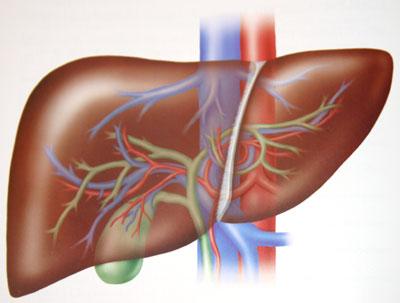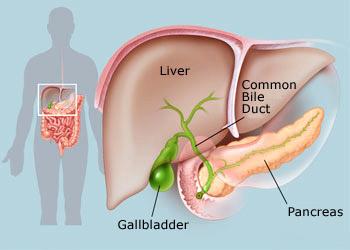 Liver acts as a basic metabolic center and the largest organ of digestive system
Liver acts as a basic metabolic center and the largest organ of digestive system The stomach and intestines get a lot of help from other organs, glands, hormones and a few nerves. Let's look at what these digestive accessories do and how they've made themselves essential to the process.
The main organ involved in digestion is the largest in the body, the liver, which accounts for about 2.5 percent of the overall body weight. The liver has a big impact on bodily functions. In terms of digestion, it is involved in breaking up, digesting and absorbing fats. The liver has multiple functions, but two of its main functions within the digestive system are to make and secrete an important substance called bile – a brownish–yellowish fluid, and to process the blood coming from the small intestine containing the nutrients just absorbed. The liver purifies this blood of many impurities before traveling to the rest of the body.
 Liver, gallbladder and pancreas acts as digestive accessories
The largest organ seen here is the liver. Below the liver is the pancreas (right) and the gallbladder (green, center left). The liver plays a vital role in metabolism, storing nutrients in forms such as glycogen, and helping to clean the blood of toxins and other waste products. It also produces bile, a liquid that is used to digest fats. The gallbladder stores and concentrates the bile, releasing it into the small intestines when needed. The pancreas secretes digestive enzymes as well as hormones, including insulin.
Liver, gallbladder and pancreas acts as digestive accessories
The largest organ seen here is the liver. Below the liver is the pancreas (right) and the gallbladder (green, center left). The liver plays a vital role in metabolism, storing nutrients in forms such as glycogen, and helping to clean the blood of toxins and other waste products. It also produces bile, a liquid that is used to digest fats. The gallbladder stores and concentrates the bile, releasing it into the small intestines when needed. The pancreas secretes digestive enzymes as well as hormones, including insulin. The liver's extra bile is stored in the gallbladder. The gallbladder is a storage sac for excess bile. Bile made in the liver travels to the small intestine via the bile ducts. If the intestine doesn't need it, the bile travels into the gallbladder where it awaits the signal from the intestines that food is present. If the gallbladder has to be removed for one reason or another, the liver just stores the extra bile in newly expanded bile ducts. Bile serves two main purposes. First, it helps absorb fats in the diet and secondly, it carries waste from the liver that cannot go through the kidneys.
The pancreas may be smaller than the liver, but it's an efficient factory. It produces pancreatic juices, which are made up of enzymes that help in digestion and are secreted into the duodenum, the first segment of the small intestine. An enzyme is a protein that can cause chemical changes in organic substances like food. The enzymes in the pancreas cause chemical changes that, with the help of bile, break down proteins, fats and carbohydrates.